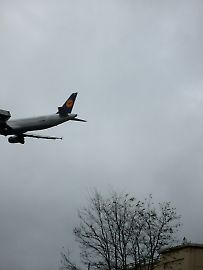Ina Weber -- kommt runter
Ina Weber’s second individual show at Georg Kargl Fine Arts presents everyday objects and quite prosaic architectures in an atypical form. The works, largely created in 2010, include watercolors and mixed media works, ceramics, and expansive sculptures.
Also in recent years, her travels have had a decisive impact on the artist’s works. Or more precisely, for Ina Weber artistic creation almost presumes the collection of personal impressions, things seen here or there. She has a passion for the urban environment in which the absurd can exist alongside the magical. Often, this is revealed in minor, unobtrusive things. She travels primarily through large cities and industrial areas where what seems apparently meaningless and the encounter of the present and the past find special attention. The artist is constantly taking pictures of her surroundings. The photographs are first placed in relation to fragments of memory. Ina Weber questions, draws her conclusions, isolates and distills the essence that seems most important to her: drawings and sculpture emerge that lie somewhere between the reconstruction of reality and its reinvention.
Ina Weber’s decisive observations can also be seen in the new series Müllsammler Shanghai. These watercolors emerged as part of a group show that was on view in the Chinese port. The curious organization of garbage collectors who belong to everyday life appealed to the artist, for one because it brings questions of recycling and sustainability to the forefront. At the same time, knowing that Ina Weber is a passionate bike rider and recalling her dedication to collecting, it quickly becomes clear that she was perhaps not just looking for differences, but also for commonalities. With great deliberateness and in her typical fashion, she animates what are essentially drawings that are free of human presence. A sense of immediacy overcomes the beholder. The works show us an individual collecting his rubbish and placing it on the scales to eek out a living.
Ina Weber’s bus stations not only can be entered, the artist intends them to be explored. A series of unconventional bus shelters in Brighton awakened her interest. For the artist, they represent “built round queues” in which those waiting are forced to line up due to the architecture, but also locations where many are overtaken by brooding, reflecting, perhaps also debate. Unlike the mass-produced architectures that seek to prevent vandalism and to keep the homeless away, these buildings are not one-dimensional, according to Weber. They offer room for everything and anyone. Her cynical-absurd point of view is woven into these sculptures up through the tiniest detail, where we can read kommt runter (come down) and bleibt kleben (stick around). The artist here is not only referring to the catalogization of various art forms—“Mosaics are up until now considered to be high art, Grafitti as low art,” as she puts it—but lets the supposed author of these words come to speak. The beholder can thus read within it a call, a demand, or a statement: stick around (like dirt). Come, stay a while, stick around.
On the bus stop Come down, Kiron Khosla writes, “This hut or cabin [...] houses the renegade. This is a place of passion: the secret teenage sex treffpunkt; the hot casual gay pick up joint and [...] hookers hangout. It Is a place for anarcho-political proselytizing as the mosaic on one wall reads Kommt runter; a sort of axiomatic imperative which could mean almost anything, from Calm down, It´s O.K., Take it easy to Bring down (destroy) all bus stops and gas stations (Kiron Koshla in: Update: Die Welt als Modell, Montagstiftung Bildende Kunst, Bonn, 2010, 82)
The title of the show not only intends to return our attention to the hard facts or to learn composure, it challenges us to not turn away from the supposed, sometimes disturbing triviality of life. Ina Weber wants to encourage us to look “elsewhere.”
Ina Weber’s works have recently been on view at Skulpturenpark Köln (–2011), Neuer Giessener Kunstverein (2009), and Kunstverein Kassel.
Text: Doris Richter
Translation: Brian Currid (zweisprachkunst.de)



















